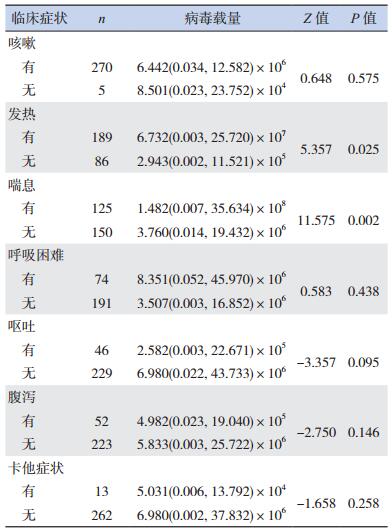急性下呼吸道感染(acute low respiratory tract infection, ALRTI)为儿童常见病、多发病,也是全球5岁以下儿童死亡的最常见原因[1]。人类博卡病毒(human bocavirus, HBoV)属于细小病毒科博卡病毒属,是瑞典学者Allander等[2] 2005年在呼吸道感染儿童中首先发现的。到目前为止,已经报道HBoV4个型别,命名为HBoV 1~4。其中HBoV1主要存在于呼吸道标本中,引起呼吸道症状,其他3个亚型主要存在于粪便标本中[3-4]。因HBoV1常与其他呼吸道病毒混合感染[5-6],其致病性一直存在争议。最近有研究表明,HBoV1可能导致严重呼吸道感染[7-8],病毒载量、混合感染或病毒血症均与呼吸道感染的严重程度相关[9-10]。
但目前有关HBoV在儿童下呼吸道感染中所起的作用,及其病毒载量与临床特征的相关性国内外研究较少。因此,本研究收集湖南省人民医院儿童医学中心ALRTI住院患儿的鼻咽抽吸物标本(nasopharyngeal suction specimens, NPAs),选用RT-FQ PCR检测包括HBoV在内的14种病毒,结合疾病严重程度评估,进一步探讨HBoV在儿童下呼吸道感染中的作用,以及病毒载量与临床特征的相关性。
1 资料与方法 1.1 研究对象选取2011年4月1日至2014年3月期间ALRTI住院患儿为研究对象,包括:肺炎,支气管炎以及毛细支气管炎等疾病,诊断标准参照文献[11];并根据严重程度指数(IOS)评估疾病严重程度[12-13],该方法以临床症状、血气分析以及住院时间、是否需要吸氧、是否需要机械通气等指标进行评分,严重性指数得分范围0~7。轻度:IOS 0~2;中度:IOS 3~5;重度:IOS 6~7。
1.2 标本采集以及临床资料获取采集患儿入院24 h内的NPAs,并加入与NPAs等量的病毒保护液,再予干冰保存转运至中国疾病预防控制中心病毒所-80℃冰箱内保存;标本采集前征得患儿父母的知情同意和医院伦理委员会批准。患儿的一般资料、临床表现、实验室检查和诊断结果均通过病历查阅获取。
1.3 实验方法采用Qiamp Minelute Virus Spin Kit双提试剂盒提取DNA及RNA。采用荧光定量PCR法检测14种相关病毒,包括RSV、HRV、IFVA-B、PIV1-4、EV、hMPV、HKU1、NL63等12种RNA病毒和ADV、HBOV 2种DNA病毒。所用引物终浓度为20 μmol/L,探针终浓度为10 μmol/L。采用Taqman Universal Master MixⅡwith UNG试剂检测DNA病毒。HBoV PCR引物见参考文献[14],反应体系为Taqman Universal Master MixⅡwith UNG 10 μL+RNA-free water 4.8 μL +引物各0.4 μL +核酸4 μL。每个循环的第二步结束时采集荧光,标准曲线相关系数 > 0.99,扩增效率90%~110%,计算出Ct值并给出定量结果,病毒载量在1×100 copies/μL以上视为阳性。
1.4 统计学分析采用SPSS 18.0软件进行数据处理。计量资料以中位数(四分位数)[P50(P25,P75)]表示,采用Mann-Whitney U检验、Kruskal-Wallis H检验。P < 0.05为差异有统计学意义。
2 结果 2.1 一般资料2011年4月1日至2014年3月31日共收集1 554份NPAs标本,其中男性患儿991例,女563例,男女比例为1.76 : 1,年龄为19 h至13岁,中位年龄12个月。1 554份标本中1 212份检出病毒,病毒检出率为77.99%,275(17.70%)份HBoV检出阳性;2011年、2012年、2013年的HBoV检出率分别为16.06%、19.65%、17.58%。HBoV阳性标本的病毒载量为1.02~1.30×1010 copies/μL,其中位病毒载量为5.830(0.005,16.721)×106 copies/μL。275例HBoV阳性的ALRTI疾病包括:急性支气管炎7例、肺炎223例、毛细支气管炎45例;其中男性患儿184例、女性91例,男女比例为2.02 : 1;年龄为10 d至8岁,中位年龄11个月, < 3岁者94.91%;单一感染45例、混合感染230例,其中混合呼吸道合胞病毒(respiratory syncytial virus, RSV)感染最常见,其次为混合人副流感病毒3型(human parainfluenza virus-3, PIV3)。
2.2 临床症状对病毒载量的影响咳嗽、发热及喘息为HBoV呼吸道感染的主要临床症状,其中发热的189例(68.73%),其HBoV病毒载量为6.732(0.003,25.720)×107 copies/L;无发热86例(31.27%),其HBoV病毒载量为2.943(0.002,11.521)×105 copies/μL,病毒载量的差异有统计学意义(P < 0.05)。喘息125例(45.45%),其HBoV病毒载量为1.482(0.007,35.634)×108 copies/μL;无喘息150例(54.55%),其HBoV病毒载量为3.760(0.014,19.432)×106 copies/μL,病毒载量的差异有统计学意义(P < 0.05)。见表 1。
| 表 1 临床症状对HBoV病毒载量的影响[P50(P25,P75),copies/μL] |
2.3 单纯或混合HBoV感染患儿的病毒载量比较
275例HBoV阳性住院患儿中,混合其他病毒感染的230例(83.6%)。单纯HBoV感染患儿的病毒载量为0.370(0.041,23.722)×107 copies/μL, 混合其他病毒感染者HBoV载量为0.582(0.033,48.502)×107 copies/μL,两者差异无统计学意义(P > 0.05)。
2.4 不同疾病严重程度患儿的HBoV载量比较45例HBoV单纯感染患儿,根据IOS疾病严重程度评估,分成轻度(33例)、中度(7例)、重度(5例)3组,其病毒载量分别为2.542(0.006,33.750)×106 copies/μL,0.671(0.003,24.732)×106 copies/μL和3.522(0.008,25.350)×107 copies/μL,3组间病毒载量的差异无统计学意义(H=3.59,P > 0.05)。230例HBoV混合感染患儿,亦分成轻度(183例)、中度(30例)、重度(17例)3组,其病毒载量分别为0.531(0.003,13.742)×106 copies/μL,3.832(0.013,29.501)×107 copies/μL,2.732(0.004,18.533)×107 copies/μL,3组间病毒载量的差异无统计学意义(H=5.63,P > 0.05)。
3 讨论急性下呼吸道感染是最常见的儿童感染性疾病之一,包括肺炎、支气管炎和毛细支气管炎等。病毒感染是其常见病原,不同年代、不同年龄、不同季节、不同地区存在不同的病毒感染种类。随着HBoV逐渐被人类认识,有研究认为HBoV也是导致儿童急性呼吸道感染的重要病原之一,甚至导致严重呼吸道感染发生[15]。本课题组前期研究证实HBoV在儿童急性下呼吸道感染的检出率为11.4%[16]。本研究HBoV的检出率为17.70%,较前上升,进一步证实HBoV已成为急性下呼吸道感染的重要病原体。Proenca-Modena等[12]认为高滴度HBoV感染更容易引起呼吸道症状。本研究急性下呼吸道感染住院患儿的HBoV载量为5.830(0.005,16.721)×106 copies/μL,参考相关文献[17],属于高病毒载量,提示HBoV导致呼吸道感染需要一定的病毒载量。
尹芳等[18]对儿童急性呼吸道感染临床特征和病毒载量之间的关系进行了分析,发现高病毒载量患儿喘息发作的概率高于低病毒载量者。本研究有喘息症状患儿的HBoV病毒载量也高于无喘息患儿。说明HBoV载量高的患儿,出现喘息症状的概率更大。
Zhou等[19]发现HBoV单纯感染与混合感染之间临床症状或疾病严重程度的差异无统计学意义,但单纯HBoV感染具有更高的病毒载量。Jiang等[10]则认为HBoV混合感染者病毒载量更高。而林创兴等[20]对儿科重症监护病房呼吸道博卡病毒感染患儿的临床特点进行研究,发现HBoV单纯感染和混合感染患儿的危重程度差异无统计学意义。朱利华等[21]则认为HBoV载量并不能反映临床感染的严重程度。本研究根据疾病严重程度指数(IOS)[12-13]
将下呼吸道感染患儿按严重程度分为轻度、中度、重度3组,表明无论是HBoV混合感染还是单纯感染,3组间的病毒载量差异均无统计学意义。与Jiang等[10]、Zhou等[19]报道不一致,提示病毒载量以及是否混合感染与疾病严重程度的关系尚不明确,需要在以后的研究中进一步证实。
综上所述,HBoV是儿童下呼吸道感染病原之一,但常与其他病原混合感染,引起临床症状需要一定的病毒载量。病毒载量高的患儿出现发热、喘息等症状可能性更大,但疾病严重程度及混合感染与病毒载量之间无显著相关性。
| [1] | Johnston SL. Overview of virus-induced airway disease[J]. Proc Am Thorac Soc, 2005, 2 (2): 150–156. DOI:10.1513/pats.200502-018AW |
| [2] | Allander T, Tammi MT, Eriksson M, et al. Cloning of a human parvovirus by molecular screening of respiratory tract samples[J]. Proc Natl Acad Sci U S A, 2005, 102 (36): 12891–12896. DOI:10.1073/pnas.0504666102 |
| [3] | Arnold JC. Human bocavirus in children[J]. Pediatr Infection Dis J, 2010, 29 (6): 557–558. DOI:10.1097/INF.0b013e3181e0747d |
| [4] | Jartti T, Hedman K, Jartti L, et al. Human bocavirus-the first 5 years[J]. Rev Med Virol, 2012, 22 (1): 46–64. DOI:10.1002/rmv.v22.1 |
| [5] | Allander T, Jartti T, Gupta S, et al. Human bocavirus and acute wheezing in children[J]. Clin Infect Dis, 2007, 44 (7): 904–910. DOI:10.1086/512196 |
| [6] | Arden KE, McErlean P, Nissen MD, et al. Frequent detection of human rhinoviruses, paramyxoviruses, coronaviruses, and bocavirus during acute respiratory tract infections[J]. J Med Virol, 2006, 78 (9): 1232–1240. DOI:10.1002/(ISSN)1096-9071 |
| [7] | Uršič T, Krivec U, Kalan G, et al. Fatal human bocavirus infection in an 18-month-old child with chronic lung disease of prematurity[J]. Pediatr Infect Dis J, 2015, 34 (1): 111–112. DOI:10.1097/INF.0000000000000509 |
| [8] | Krakau M, Gerbershagen K, Frost U, et al. Case report:human bocavirus associated pneumonia as cause of acute injury, Cologne, Germany[J]. Medicine (Baltimore), 2015, 94 (42): e1587. DOI:10.1097/MD.0000000000001587 |
| [9] | Zhao B, Yu X, Wang C, et al. High human bocavirus viral load is associated with disease severity in children under five years of age[J]. PLoS One, 2013, 8 (4): e62318. DOI:10.1371/journal.pone.0062318 |
| [10] | Jiang W, Yin F, Zhou W, et al. Clinical significance of different virus load of human bocavirus in patients with lower respiratory tract infection[J]. Sci Rep, 2016, 6 : 20246. DOI:10.1038/srep20246 |
| [11] | 申昆仑, 江载芳.呼吸系统疾病[M]//胡亚美, 江载芳, 诸福棠.实用儿科学上册.第7版.北京:人民卫生出版社, 2002, 1171-1214. |
| [12] | Proenca-Modena JL, Gagliardi TB, Escremde Paula F, et al. Detection of human bocavirus mRNA in respiratory secretions correlates with high viral load and concurrent diarrhea[J]. PLoS One, 2011, 6 (6): e21083. DOI:10.1371/journal.pone.0021083 |
| [13] | Walsh EE, McConnochie KM, Long CE, et al. Severity of respiratory syncytial virus infection is related to virus strain[J]. J Infect Dis, 1997, 175 : 814–820. DOI:10.1086/jid.1997.175.issue-4 |
| [14] | Kantola K, Sadeghi M, Antikainen J, et al. Real-time quantitative PCR detection of four human bocaviruses[J]. J Clin Microbiol, 2010, 48 (11): 4044–4050. DOI:10.1128/JCM.00686-10 |
| [15] | Edner N, Castillo-Rodas P, Falk L, et al. Life-threatening respiratory tract disease with human bocavirus-1 infection in a 4-year-old child[J]. J Clin Microbiol, 2012, 50 (2): 531–532. DOI:10.1128/JCM.05706-11 |
| [16] | 肖霓光, 张兵, 段招军, 等. 长沙地区急性下呼吸道感染住院儿童人博卡病毒感染的初步研究[J]. 临床儿科杂志, 2011, 29 (6): 510–513. |
| [17] | Kim JS, Lim CS, Kim YK, et al. Human bocavirus in patients with respiratory tract in fection[J]. Korean J Lab Med, 2011, 31 (3): 179–184. DOI:10.3343/kjlm.2011.31.3.179 |
| [18] | 尹芳, 周卫芳, 王美娟, 等. 人类博卡病毒载量与儿童呼吸道感染临床特征的相关性[J]. 中国传染病杂志, 2014, 32 (6): 343–348. |
| [19] | Zhou L, Zheng S, Xiao Q, et al. Single detection of human bocavirus 1 with a high viral load in severe respiratory tract infections in previously healthy children[J]. BMC Infect Dis, 2014, 14 : 424. DOI:10.1186/1471-2334-14-424 |
| [20] | 林创兴, 陆学东, 林广裕, 等. 儿科重症监护病房患儿博卡病毒感染的临床分析[J]. 国际儿科学杂志, 2014, 41 (4): 424–426. |
| [21] | 朱利华, 许会卿, 覃世榕, 等. 儿童急性呼吸道博卡病毒感染的病毒载量与临床特征相关性研究[J]. 中华实验和临床病毒学杂志, 2011, 25 (4): 271–273. |
 2017, Vol. 19
2017, Vol. 19



